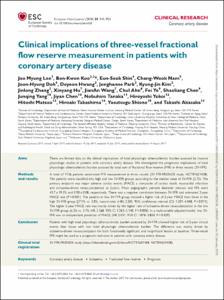KUMEL Repository
1. Journal Papers (연구논문)
1. School of Medicine (의과대학)
Dept. of Internal Medicine (내과학)
Clinical implications of three-vessel fractional flow reserve measurement in patients with coronary artery disease
- Affiliated Author(s)
- 남창욱
- Alternative Author(s)
- Nam, Chang Wook
- Journal Title
- European Heart Journal
- ISSN
- 0195-668X
- Issued Date
- 2018
- Abstract
- Aims:
There are limited data on the clinical implications of total physiologic atherosclerotic burden assessed by invasive physiologic studies in patients with coronary artery disease. We investigated the prognostic implications of total physiologic atherosclerotic burden assessed by total sum of fractional flow reserve (FFR) in three vessels (3V-FFR).
Methods and results:
A total of 1136 patients underwent FFR measurement in three vessels (3V FFR-FRIENDS study, NCT01621438). The patients were classified into high and low 3V-FFR groups according to the median value of 3V-FFR (2.72). The primary endpoint was major adverse cardiac events (MACE, a composite of cardiac death, myocardial infarction and ischaemia-driven revascularization) at 2 years. Mean angiographic percent diameter stenosis and FFR were 43.7 ± 19.3% and 0.90 ± 0.08, respectively. There was a negative correlation between 3V-FFR and estimated 2-year MACE rate (P < 0.001). The patients in low 3V-FFR group showed a higher risk of 2-year MACE than those in the high 3V-FFR group [(7.1% vs. 3.8%, hazard ratio (HR) 2.205, 95% confidence interval (CI) 1.201-4.048, P = 0.011]. The higher 2-year MACE rate was mainly driven by the higher rate of ischaemia-driven revascularization in the low 3V-FFR group (6.2% vs. 2.7%, HR 2.568, 95% CI 1.283-5.140, P = 0.008). In a multivariable adjusted model, low 3V-FFR was an independent predictor of MACE (HR 2.031, 95% CI 1.078-3.830, P = 0.029).
Conclusion:
Patients with high total physiologic atherosclerotic burden assessed by 3V-FFR showed higher risk of 2-year clinical events than those with low total physiologic atherosclerotic burden. The difference was mainly driven by ischaemia-driven revascularization for both functionally significant and insignificant lesions at baseline. Three-vessel FFR might be used as a prognostic indicator in patients with coronary artery disease.
- Department
- Dept. of Internal Medicine (내과학)
- Publisher
- School of Medicine (의과대학)
- Citation
- Junqing Yang et al. (2018). Clinical implications of three-vessel fractional flow reserve measurement in patients with coronary artery disease. European Heart Journal, 39(11), 945–945. doi: 10.1093/eurheartj/ehx458
- Type
- Article
- ISSN
- 0195-668X
- Appears in Collections:
- 1. School of Medicine (의과대학) > Dept. of Internal Medicine (내과학)
- 파일 목록
-
-
Download
 oak-2018-0237.pdf
기타 데이터 / 478.38 kB / Adobe PDF
oak-2018-0237.pdf
기타 데이터 / 478.38 kB / Adobe PDF
-
Items in Repository are protected by copyright, with all rights reserved, unless otherwise indicated.